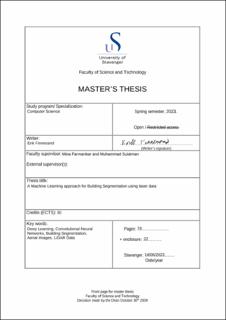| dc.description.abstract | Buildings are essential for population information, city management, and policy-making. Various computer vision technologies have proven helpful in building-related scenarios, where segmentation has proven to be the most precise method as it highlights areas of interest. The thesis is based on the NORA MapAI competition, which tasks the participant to create machine-learning models for generating accurate segmentation masks of buildings. The competition is split into two tasks, where task 1 requires the use of only aerial images, and task 2 requires the use of LiDAR data with or without aerial images. This is done by using two different encoder-decoder architectures, UNet, and Context-Transfer-UNet (CT-UNet), and four different backbones, ResNet50V2, DenseNet201, EfficientNetB4, and EfficientNetV2S. Data augmentation, transfer learning, model ensembles, and test time augmentation (TTA) have been used to achieve greater results. The final results of the thesis show that the proposed solution achieves state-of-the-art results, as we achieve the best score for every metric in each task compared to the other participants. | |
